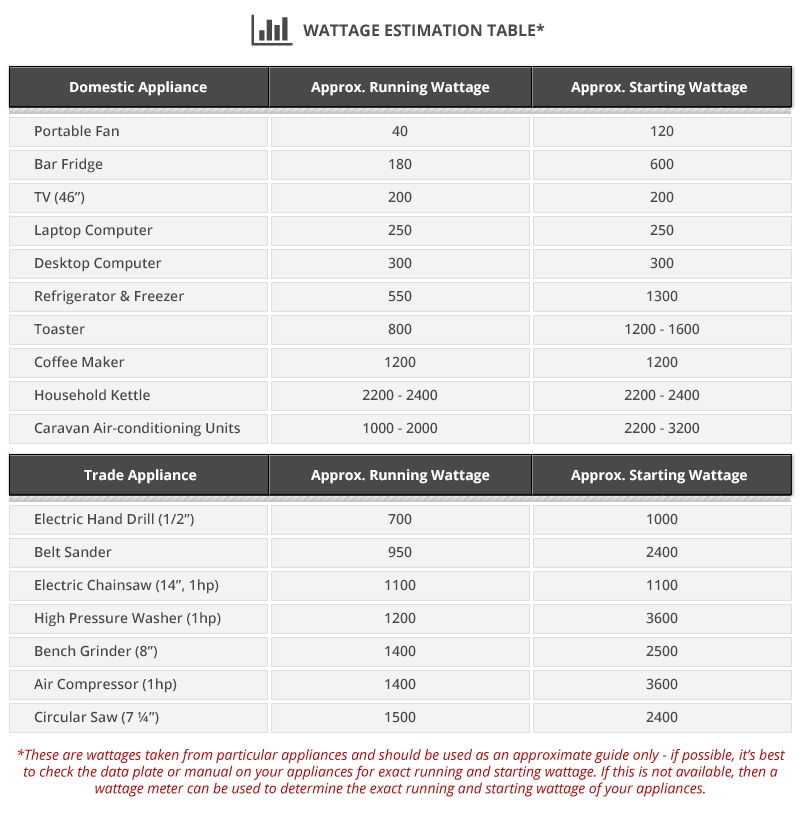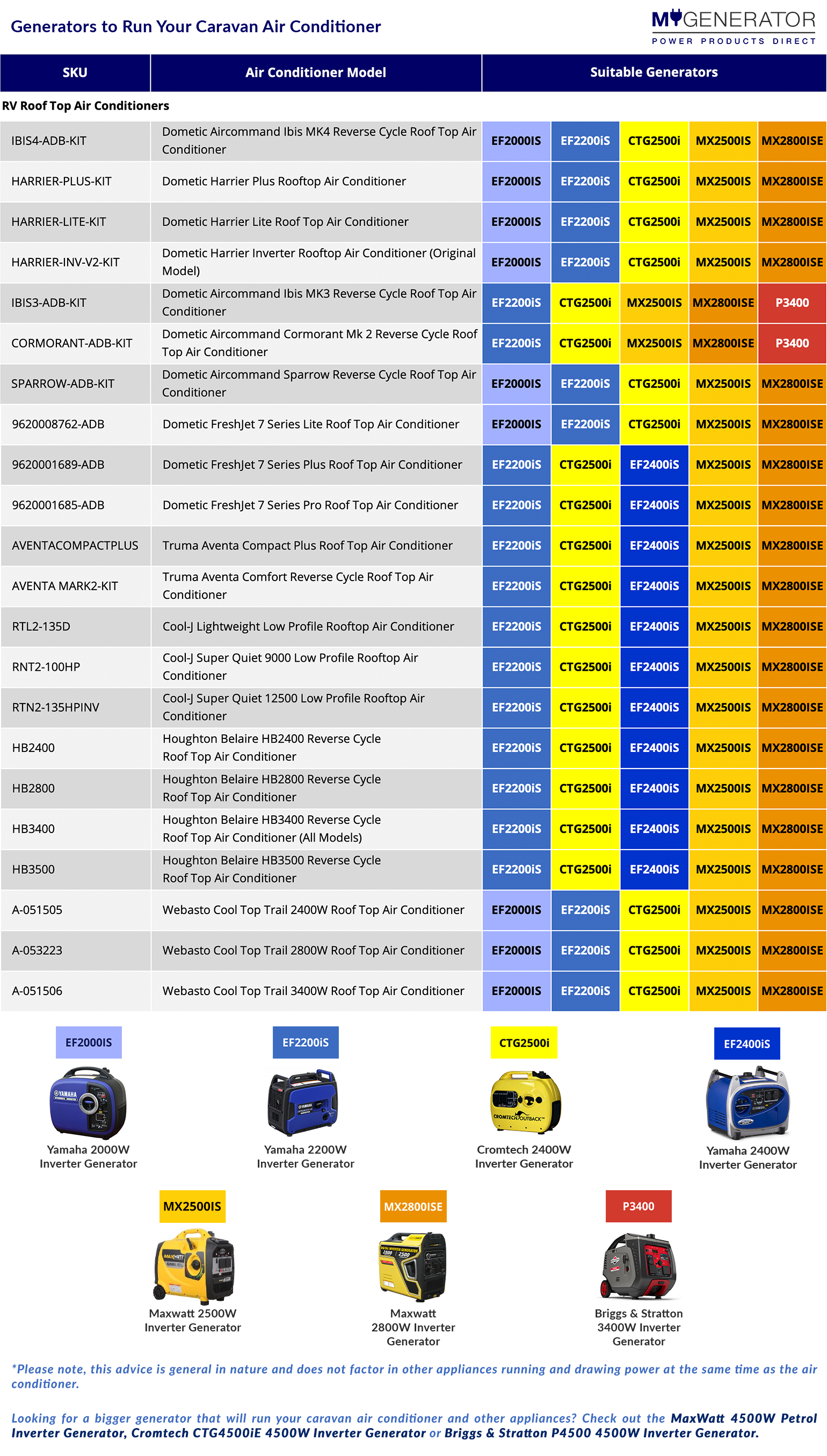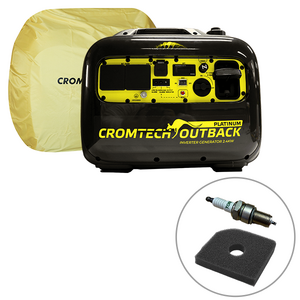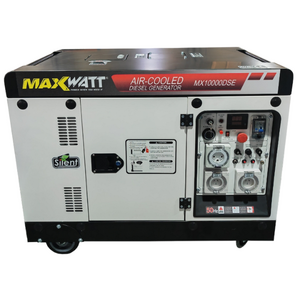My Generator Power Calculator
“WHAT SIZE GENERATOR DO I NEED?”…this is the most commonly asked portable generator question and can sometimes seem like quite a technical, challenging task. But for most applications, it’s actually pretty simple and straightforward – here we try and make it easy for you.
First follow these three simple steps;
- Get the power information for your appliances - both running and starting power (if appliacable)
- Make sure the power information is represented in Watts
- Work out how many appliances you'll be running at any one time
Read on for more detail how to go about completing each of the steps. Then we have also included some useful case studies below of customers with some very common applications and how they correctly sized their portable generator.
Note: this sizing advice relates to portable generators – if you are after generator sizing advice for a large stationary generator, then you may need to engage an electrician.
To begin, you need to know the wattage draw of your appliance(s) and make sure your generator produces enough power to handle that draw – lets’ do it;
Step 1: Getting the power information for your appliances
Determine the running (continuous) watts and starting (peak) watts needed for each appliance. In some instances, these will be the same – this is the case for appliances such as TV’s, lights and laptops whereby the starting and running wattage is the same.
But in lots of other instances (i.e. appliances that have electric motors or heating elements) the starting wattage can be multiple (3-4 times or more) of the running/continuous wattage. Examples of these types of appliances are; fridges, air-conditioners, microwaves, electric deep fryers, coffee machines, hair dryers, pumps, drills, grinders, saws etc. These appliances have motors, compressors or heating elements that will surge to a peak power demand then drop back down to a lower running/continuous amount.
So where applicable, it is very important you obtain the starting wattage for your appliance, because if your appliance(s) draw more power when surging than the generator can produce, then you won’t be able to run your appliances.
Note that often the important starting wattage amount isn't always stated in the product manual or on the product data plate, so you may need to contact the appliance manufacturer or use a wattage meter to get the right starting/peak wattage amount. Here's a quick video of the easy steps to take when sizing the right generator for you:
Step 2: Making sure the power information is represented in Watts (W)
If your appliance power information is represented in Amps (A), Kilowatts (kW, kVA), or Horsepower (HP), then you will need to convert these figures to Watts (W); refer to the following Power Reference if needed;
Power Reference Table
| Amps | Converted into Watts | |
| 1 x Amp = 240 watts |
Note: this is for AC Single Phase power. Three Phase Power runs at 400 - 415 volts
| HP | Converted into Watts | |
| 1 x HP = 746 watts |
| kW | Converted into Watts | |
| 1 x kW = 1000 watts | ||
| kVA | Power Factor | Converted into Watts | |
| kVA = kW/Power Factor | Between 0 and 1 |
Step 3: Work out how many appliances will you be running at any one time
If you are only running one appliance from your generator, then simply use the wattage information you have obtained from the above steps and choose a generator size accordingly. A couple of examples;
- Your Caravan Air-conditioner draws 2300 watts at start up and drops back to 1000 watts continuous. You wisely opt for a Yamaha EF2400iS which produces 2400 watts at peak and 2000 watts continuous…a good fit for your Caravan air-con unit.
- The Water Pump on your farm draws 30 Amps (7200 Watts) to start up and then drops back down to 1800 watts to keep running. You opt for an 8kVA Powerlite Generator which can handle up to 8000 watts at peak; this is the most popular trade and farm generator.
But what if you want to run multiple appliances from your generator at the one time? There are few different things to consider in this situation. Firstly, we’ll take a look at a simple example;
- Again, you want to run your Caravan Air-conditioner and some other small appliances as well:
| Appliance | Running Wattage | Starting Wattage |
| Caravan Air-Conditioner | 1000 | 2300 |
| TV | 200 | 0 |
| Mobile Phone/Tablet | 100 | 0 |
Simply add the highest starting wattage number (2300 watts) to the wattage sum of the other two appliances, i.e. 2300 + 200 +100 = 2600 watts. In this instance you choose a Yamaha EF2800iS which produces a peak power of 2800 watts and rated output of 2500 watts.
The above example is quite basic as there is only one appliance that surges at start up. Let’s take a look at an example of running multiple appliances with surge power requirements as there are a couple of ways to approach it. An important note here is that to maximise the generator potential, the appliance with the largest starting wattage should be started on its own first and then further appliances connected thereafter. Example;
- After a storm in your area there is a blackout and you need to run some home appliances:
Appliance Running Wattage Starting Wattage Fridge/Freezer 400 1280 Water Pump 300 1100 TV 200 0 Lights 60 0 Laptop 120 0
You could choose a 2000w generator, as the highest starting wattage appliance (Fridge/Freezer) is 1280 watts and the sum of the running watts of the other appliances is 680 watts, so; 1280 + 680 = 1960 Watts. You would start first with connecting your Fridge/Freezer, then incrementally add your other appliances.
However, if the two appliances with starting wattage requirements (Fridge/Freezer and Water Pump) both surged at the same time this would require 2760 Watts (1280 + 1100 + 200 + 60 + 120), then the 2000w generator would not produce enough power. It would trip the overload circuit breaker and stop producing power. Therefore if you wanted to run multiple appliances at the same time that have surging power requirements and their peak power demand will coincide, then you will need to choose a generator size that can handle the sum of the peak demands at any one time plus the sum of the running wattages for the remaining appliances. If this is the case, then you would need a generator that could produce above 2760 Watts.

If you still require help getting the right sized generator for your application, then feel free to give our expert customer service team a call on 1300 400 122. Additionally, you may also find our case studies helpful - here we show examples of how real customers sized the right portable generator for their needs;
My Generator Case Studies
Barry and Sue are about to head on a Caravan trip and want a generator to run their Caravan Air-Conditioner and also have the generator as a backup option to charge their deep-cycle batteries if needed. They first contacted the air conditioning manufacturer who informs them that their unit requires 9.5 Amps at start up and then drops back down to 4.2 Amps to run continuously. So, they converted these figures to watts by referring to the above Power Reference Table:
| Air-Con Power Requirements | Amps | Convert to Watts |
| Starting Air Conditioner | 9.5 | 2280 |
| Running Air Conditioner | 4.2 | 1008 |
…So Barry and Sue needed a generator which could deliver greater than 2280 watts at start up. They purchased a Yamaha 2400iS which produces 2400 watts at max and was able to run their caravan air conditioner comfortably. It also served as a great back up option to charge their deep-cycle batteries if needed.
More often than not, the manufacturer of your caravan Air Conditioner will not know the specific start up current of the Air Conditioner. Dometic’s modern inverter controlled Rooftop Air Conditioners no longer have a start-up peak power demand, so choosing a Generator to power those has become a lot easier.
Using our vast industry knowledge and consumer feedback, we’ve developed a simple table with a recommended generator to run most caravan air conditioners on the market. See below:
Glen and his family live in an area prone to blackouts. During a mains outage after a storm he wants to run his fridge/freezer most importantly, as well as a smaller fridge and then other some appliances; lights, fan and the TV. Each appliance has the input wattage requirements displayed on the dataplate/product label or in the manual. Here is the summary of the power requirements:
| Appliance | Running Wattage | Starting Wattage |
| Main Fridge/Freezer | 620 | 1500 |
| Small Fridge | 200 | 650 |
| TV | 220 | - |
| Lights | 100 | - |
| Fan | 80 | - |
Running all of the above at the same time means the two fridges could require a peak power demand together of 2150 watts and then you have the three other smaller appliances requiring a sum of 400 watts. So adding those two figures we know Glen needs a generator that can deliver greater than 2550 watts at maximum and greater than 1220 watts continuously. Glen purchased the Yamaha EF2800iS which delivers a peak of 2800 watts and rated power of 2500 watts. This unit is very popular for this type of application, as it also includes a long range fuel tank with up to 17 hours running time at quarter load; great for backup power at home during periods of prolonged power blackout.
Nick is a plumber and needs a trade generator to run tools on unpowered construction sites. He needs to run an air compressor and a pressure washer. The air compressor is 3.8kW startup and 1.1kW running. Lastly, the pressure washer manual indicates it needs 15.0 Amps max and 5.4 Amps continuous. First, he needs to convert everything to watts so he refers to the above Power Reference Table;
| kW | Convert to Watts | |
| Air Compressor Starting | 3.8 | 3,800 |
| Air Compressor Running | 1.1 | 1,100 |
| Amps | Convert to Watts | |
| Pressure Washer Starting | 15.0 | 3,600 |
| Pressure Washer Running | 5.4 | 1,296 |
Now he has the required Watts information and can use that to size the right generator:
| Appliance | Running Watts | Starting Watts |
| Air Compressor | 1,100 | 3,800 |
| Pressure Washer | 1,296 | 3,600 |
| TOTAL | 2,396 | 7,400 |
-
-
Best Sellers:

MaxWatt 6000W Petrol Inverter Generator with 2 Wire Auto Start, 2 Year Warranty
$2,399 RRP: $2,599 Save: $200











